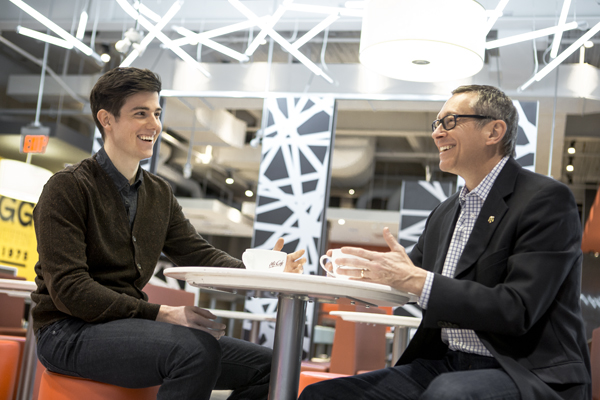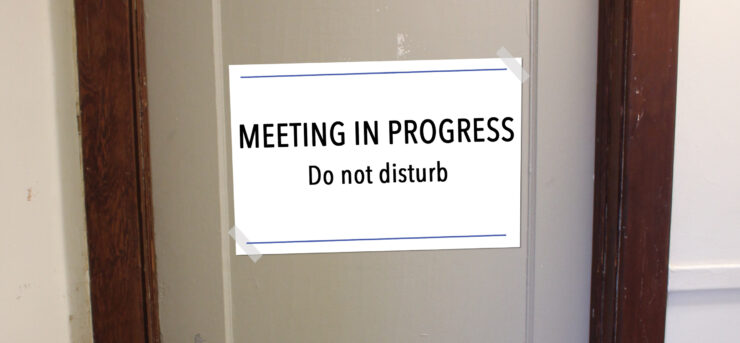With the cuddle industry on the rise, are Canadians coming around to the idea of paying for non–sexual contact?
On a frigid Monday afternoon I finally came face-to-face with Rachel, a young woman whose services I had purchased online over the weekend.
We met up at an A&W on Hunt Club Road, and one of the first things she asked me was if I had done this sort of thing before, to which I nervously answered, “No.”
Once these awkward formalities were out of the way, we walked to her apartment and crawled into a bed that she had set up in her living room.
I paid for 30 minutes, which gave us plenty of time to try out a variety of positions I was curious about, including the “68 1/2” and something called “cherry popsicles.”
After my session was over, Rachel generously made me some tea and I left her apartment feeling a little shady, but relaxed nonetheless.
What I neglected to mention up until this point is that Rachel is a professional cuddler, and all of the positions we performed together were strictly platonic in nature (outlined in a comprehensive document called “The Cuddle Sutra”).
Thanks to the Cuddlery—the company that employs Rachel—this service has been available to Ottawans in an official capacity since January 2015. It began in Vancouver in 2014 and it has expanded to most major Canadian cities since that time.
In fact, businesses like this have been popping up across Canada and the United States over the last couple years, united under a collective objective to alleviate anxiety and loneliness through the power of non-sexual touch.
Despite knowing this going into my cuddle session with Rachel, the whole thing still felt weird. All my life I’ve been told that this kind of intimate contact should be reserved for family members and sexual partners only.
But should it be?
Organizations like the Cuddlery are out to challenge that assumption through their business model, which is predicated on the idea that platonic intimacy is something that can be shared between complete strangers.
Professional snuggling throughout the years
Even though professional snuggling businesses have only become prominent over the past few years, this kind of service can be traced back to 2004, where relationship expert Reid Mihalko began organizing adult “cuddle parties” in Manhattan.
This idea was later expanded upon sometime around 2008, when Travis Sigley—a former male entertainer from San Francisco—launched what many consider to be the first professional cuddling service called Cuddle Therapy.
Since then more than 20 cuddling businesses have been set up in North America, including organizations native to Canada such as The Cuddle Co and Cuddleme.ca.
There’s even a mobile app called Spoonr available for cuddlers on the go, while those who enjoy more public displays of affection can attend large-scale social events, like last year’s Cuddle Con in Portland, Oregon.
One of Canada’s first professional cuddling services to emerge from this popularity spike is the Cuddlery, founded in 2014 by University of Ottawa graduate Marylen Reid.

Photo courtesy of Marylen Reid.
Reid’s time studying law at the U of O largely inspired her to launch the Cuddlery, since prepping for midterms and exams far away from her home city of Vancouver left her feeling lonely and mentally strained.
“Like anyone who is stressed out, what I needed was a good cuddle and it was hard to find. I went online to try to find cuddle buddies and… it was not the best way to do it,” she said, referring to dating websites which are designed for, whether intentionally or not, sexual encounters. “So I was thinking if only such a service existed, I would use it.”
Once Reid graduated from law school in 2013, she started out on a mission to establish a physical intimacy service in Canada where sexual intercourse isn’t implied at the outset.
“When there’s no possibility of sex it’s more relaxing, calming, accepting, and it’s a totally different experience.”
Cuddling 101
Of course, one of the many challenges that Reid ran into once she decided to start up her own paid snuggling business is recruiting employees who possess the right temperament and skill set for the job.
“Last year we had more than 1,300 applications,” she said. “(But) no one was good enough or good by my standards.”
To fix this problem, Reid created her own training program and the screening process for these positions came with a more specific set of requirements.
“You’re looking for a lot of different criteria, like non-judgemental, the faculty of being able to care, and genuine care for other people, even strangers. And, of course, the cuddling skills.”
One of the candidates who met all these requirements is Rachel Molloy (the cuddler I hired), who performs these sessions two to four times a month, in addition to her other gigs as a model, actress, dancer, author, lab technician, and flower shop employee.

Photo courtesy of Rachel Molloy.
After going through Reid’s vigorous training program, Molloy is now equipped with a number of cozy moves in her arsenal, including an especially effective “cuddly massage” that almost put me to sleep right on the spot.
“I find when clients get nervous then it’s just easier to say ‘would you like to try the cuddly massage?’ and it helps relax them a little bit, which is what you want from a session.”
While Molloy is not worried about inviting strangers into her home for these intimate encounters, she admits that certain security measures must be taken to ensure her safety.
“There’s a meeting beforehand to kind of get to know each other. You can meet as many times as you want before the actual session, but you can usually sense (the client’s character) pretty quickly.”
She also discloses the very important fact that “Every cuddler has a right to say ‘no’, even before they accept a client.”
Additionally, as per company policy, each cuddle session is video-taped to guarantee that there is no misconduct on the part of both participants. The recording is later deleted after it is reviewed by the cuddler. Security measures like this are not universal for all cuddling companies, but businesses like the Cuddlery would like to establish video recording as an industry standard.
But despite having to take these serious precautionary measures, Molloy still believes that this whole process is worth it in the end, since it helps her clients abate unpleasant emotions that she knows all too well.
“For me personally, I understand that kind of loneliness, moving to a new city and not knowing anyone,” she said, having just moved to Ottawa back in August.
“They don’t have to feel like they need to be alone. Because when I see people being alone and kind of stuck in that cycle it just gets worse.”
A hug a day…
The health benefits of cuddling that Molloy hints at aren’t just based on some arbitrary, incalculable sense of “feeling good” or not. It’s actually backed up by science.
“Cuddling releases oxytocin in the brain,” said Reid, referring to a hormone that scientists have tied to the lowering of blood pressure, reducing depression, and relieving stress. “So it has been proven that cuddling is fostering well-being.”
Molloy also chimes in by saying that these benefits also apply to a broader social context.
“Touch is so essential in how we communicate. It’s a skill you need for networking, you know? And people are starting to realize that to get back in touch with this is essential if you want to advance in a career, or a social life.”
On the flip side of the spectrum, according to the Touch Institutes at the University of Miami, someone who lacks intimate contact in their lives (especially at a young age) is at risk of delayed development in areas such as weight gain, motor skills, and cognitive skills.
Unfortunately, more Canadians than ever might be susceptible to these drawbacks.
According to 2011 census figures, 27.6 per cent of the population chooses to live alone, a number that is more than double the single occupancy rate from 1971.
This increasingly isolated existence is exacerbated by the fact that, in Western society at least, intimate physical touch between strangers is heavily frowned upon. This is particularly true for men, a social stigma that is fuelled by equal parts homophobia and sex offender concerns.
Sadly, Reid remarks that this attitude manages to manifest itself in the clients they receive, many of whom are “still ashamed to get such a service.”
This cultural sheepishness surrounding professional cuddling is unfortunate, especially since the diverse clientele that the Cuddlery receives seems to indicate that this service is needed for Canadians from all walks of life.
“There’s the person that is too busy, for example a business man. There are women who have given up on online dating because it’s crap. There are people who are in pain because they found out that they have a terminal disease, or they’ve lost their wife or their husband,” said Reid.
“One type of client we’re proud to serve is people with disabilities that are having difficulty going out of their house, or women who have been sexually abused and they have to learn how to touch again.”
Fifty shades of intimacy
Still, despite the numerous health advantages, the cuddling industry’s close proximity to the sex trade—in that they both monetize physical touch—might be too much for some Canadians to accept.
Molloy experiences these kinds of sentiments first-hand whenever she tells anybody about her part-time job.
“Either they ask questions or they’re afraid to ask questions,” she said. “The people that do make comments, there’s a lot of ‘Oh, I can’t see myself paying for that service.’”
With that being said, some of these comparisons between the cuddle industry and the sex trade are definitely justified.
After all, U of O law professor Christine Bruckert—who has been researching the sex trade for more than two decades—points out that a lot of people who solicit prostitution don’t do it just for the sake of intercourse.
“There’s all sorts of different kinds of touch that people are anxious to have and aren’t finding in their lives or through other channels. And sex is one of those, but other kinds of contact are as well.”
“And sex workers will tell you that they spend a lot of time talking and cuddling and doing what’s called the ‘girlfriend experience’ or the ‘boyfriend experience.’”
However, Bruckert believes that the sex trade’s thematic overlap with paid snuggling isn’t an inherently bad thing.
“I think it’s just a spectrum of different kinds of intimacy you can purchase and I suppose someone who’s buying a cuddling service very explicitly does not want to have sexual contact. So I see it more along that line as part of a continuum of emotional, intimate, sexual services that are now being offered in a commercial context.”
Cozying up to the masses
While Reid definitely wants to expand the scope of her business in the future, she believes that their primary focus should be on education and training.
“Our next challenge for the Cuddlery is really to educate people who are wanting high-quality cuddling. A lot of people are not aware that there is such a thing,” she said. “So what we want is more education (and) training for people to become better cuddlers.”
Whether or not this strategy will allow this industry to go mainstream is anyone’s guess.

Photo courtesy of Marylen Reid.
As it stands, in a time when Canadians are becoming increasingly isolated because of chosen living conditions and advances in mobile technology, the paid snuggling business remains a viable market for those who crave, but are in short supply of, human contact.
And if you’re still one of those people who are hesitant to share close proximity with a random man or woman, Reid believes that this mental barrier can be broken down with a simple change of perspective.
“I think that with my job I (finally) understood the meaning of intimacy, and it’s not sharing your life with someone as girlfriend or boyfriend. It’s willing to be honest and vulnerable with someone.”





